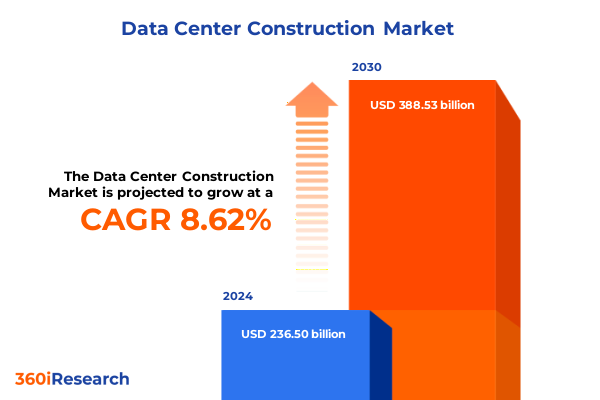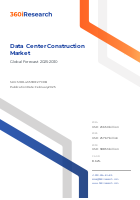The Data Center Construction Market size was estimated at USD 236.50 billion in 2024 and expected to reach USD 257.67 billion in 2025, at a CAGR 8.62% to reach USD 388.53 billion by 2030.

Introduction to the evolving data center construction landscape
The data center construction sector is at a pivotal juncture as organizations worldwide accelerate digital transformation initiatives. Driven by surging demand for cloud services, AI workloads, and high-performance computing, this market’s ecosystem continually evolves to support unprecedented capacity, resilience, and efficiency requirements. As stakeholders confront supply chain constraints, shifting regulatory landscapes, and sustainability mandates, they must navigate complex interdependencies across facility types, infrastructure components, and service models. This executive summary distills critical insights into the forces reshaping construction strategies, the implications of new trade tariffs, and the segmentation trends guiding capital allocation. By framing these dynamics in a clear, decision-ready context, executives and project leaders can align investment priorities with emerging opportunities and potential risks. The following analysis lays the groundwork for informed planning, offering actionable perspectives to enhance competitive positioning in an environment characterized by rapid innovation and escalating cost pressures.
Transformative shifts redefining construction strategies
Emerging technologies and business priorities are triggering transformative shifts across the data center construction industry. Hyperscale deployments now anchor cloud giants’ expansion plans, elevating demand for standardized modular designs that accelerate time to market. Concurrently, enterprises are revisiting colocation partnerships to optimize capital outlays while ensuring uptime forecasts remain intact. On the infrastructure front, the push toward decarbonization has sparked adoption of high-efficiency chillers, on-site renewables, and advanced power distribution units that collectively reduce operational carbon footprints. At the same time, integration of AI-driven building management systems is enabling predictive maintenance models, slashing downtime and maintenance costs. Geopolitical realignments are prompting supply chain realignments, with regional sourcing strategies gaining prominence to mitigate tariff exposure and logistics delays. This confluence of technology evolution, sustainability imperatives, and risk mitigation strategies underscores a paradigm shift: data center construction must be built around agility, resilience, and environmental stewardship.
Cumulative impact of U.S. tariffs in 2025 on project costs
In 2025, new tariffs on critical data center components have introduced significant cost headwinds, prompting a repositioning of procurement strategies across the United States. Equipment imported from traditional manufacturing hubs now carries elevated duties, directly impacting pricing for generators, switchgear, and chillers. As a result, many integrators and developers are negotiating longer-term contracts or shifting to regional suppliers to stabilize input costs. The cascading effect has been felt most acutely in raw material markets, where steel and copper premiums have risen in tandem with duty adjustments. Project budgets are systematically incorporating revised duty schedules to maintain margin targets, with financial models recalibrated for potential further escalations. To offset these increases, some operators are accelerating deployments of modular prefabrication, reducing on-site labor expenses and schedule uncertainties. Ultimately, the cumulative tariff impact is reshaping vendor selection criteria, compelling stakeholders to balance cost, quality, and supply chain resilience more rigorously than before.
Key segmentation insights across facility, infrastructure, and services
Segmenting the market by facility type reveals distinct value drivers for colocation providers, enterprises, and hyperscale operators. Colocation projects prioritize space efficiency and standardized rack capacities to maximize revenue per square foot, whereas enterprise-owned centers focus on tailored security and customized redundancy levels. Hyperscale developments, by contrast, leverage economies of scale to drive cost per kilowatt below sustainable thresholds. When evaluating infrastructure categories-electrical, mechanical, and general construction-the electrical domain encompasses critical assets such as generators, power distribution units, transfer switches, switchgear, and uninterruptible power supplies, all engineered for reliability. Mechanical infrastructure spans cooling systems, including air conditioners, chillers, and cooling towers alongside rack deployments designed for optimized airflow. General construction integrates building development, engineering-procurement-construction management, and installation-commissioning to deliver turnkey readiness. Construction typologies differentiate brownfield retrofits from greenfield expansions, each presenting unique logistical and permitting challenges. Tier standards further stratify risk tolerance and uptime expectations across Tier I through Tier IV classifications, influencing design complexity. Service offerings extend from design and engineering to installation, deployment, and ongoing maintenance and support. Application segments encompass banking, finance services and insurance, energy, government and defense, healthcare, life sciences, IT & telecommunications, manufacturing, and retail, each imposing specific compliance and performance criteria. Technology trends are clustered around AI and machine learning-spanning computer vision, deep learning, and natural language processing-alongside big data frameworks such as Hadoop, cloud computing architectures, and Internet of Things platforms. End users range from cloud service providers and colocation specialists to industry-specific enterprises and IT service firms, each sourcing construction partners aligned with their strategic growth trajectories.
This comprehensive research report categorizes the Data Center Construction market into clearly defined segments, providing a detailed analysis of emerging trends and precise revenue forecasts to support strategic decision-making.
- Facility Type
- Infrastructure Type
- Construction Type
- Tier Standards
- Services
- Applications
- Technology
- End User
Key regional insights shaping global development
The Americas region continues to lead in new capacity additions, supported by robust capital investment in hyperscale campuses and colocation expansions along major connectivity corridors. In Europe, Middle East & Africa, regulatory incentives for energy efficiency and renewable integration are unlocking new thermal management technologies and greenfield opportunities. Meanwhile, Asia-Pacific is witnessing a rapid uptick in edge data centers to serve high-density urban markets, with local governments offering tax breaks for domestically sourced infrastructure components. Across all regions, regional supply chain realignments are influencing lead times and cost structures, encouraging on-shore manufacturing partnerships and tiered sourcing maps to balance speed with risk mitigation. These geographic dynamics are shaping where and how companies allocate resources, laying the groundwork for differentiated competitive strategies.
This comprehensive research report examines key regions that drive the evolution of the Data Center Construction market, offering deep insights into regional trends, growth factors, and industry developments that are influencing market performance.
- Americas
- Asia-Pacific
- Europe, Middle East & Africa
Key companies insights and competitive landscape
Leading players in data center construction span global engineering giants and specialized integrators. AECOM and Bechtel are renowned for large-scale greenfield master plans, while Arup Group Ltd. and Exyte GmbH by M+W Group deliver high-complexity design and engineering excellence. Turner Construction Company and Hensel Phelps & Company excel in turnkey project delivery, and Clune Construction Company and HITT Contracting Inc. bring deep expertise in rapid deployment models. Specialist firms such as Collen Construction Limited and Suir Engineering Ltd offer agile solutions in emerging markets, with dataR GmbH and Nikom InfraSolutions focusing on precision retrofits. Developers and operators including CyrusOne and DigitalBridge Group, Inc. are vertically integrated, overseeing both facility development and operational phases. Equans Data Centers and Fortis Construction Inc. emphasize sustainable build practices, while John Sisk & Son, DPR Construction, J. E. Dunn Construction Group, Mercury Engineering, Soben, STO Building Group, and Züblin AG round out a competitive landscape characterized by diverse capabilities and global footprints.
This comprehensive research report delivers an in-depth overview of the principal market players in the Data Center Construction market, evaluating their market share, strategic initiatives, and competitive positioning to illuminate the factors shaping the competitive landscape.
- AECOM
- Arup Group Ltd.
- Bechtel
- CAP INGELEC
- Clune Construction Company
- Collen Construction Limited
- CyrusOne
- dataR GmbH
- DigitalBridge Group, Inc.
- DPR Construction
- Equans Data Centers
- Exyte GmbH by M+W Group
- Fortis Construction Inc.
- Hensel Phelps & Company
- HITT Contracting Inc.
- J. E. Dunn Construction Group
- John Sisk & Son
- M.A. Mortenson Company
- Mercury Engineering
- Nikom InfraSolutions
- Soben
- STO Building Group
- Suir Engineering Ltd
- Turner Construction Company
- Züblin AG
Actionable recommendations for industry leaders
Industry leaders should prioritize integrated digital twin platforms that unify electrical, mechanical, and architectural data streams to enhance real-time decision making. Embracing modular prefabrication for electrical skids and cooling plant modules can dramatically shorten construction schedules while improving quality control. To mitigate tariff volatility, negotiating multi-year vendor agreements and developing dual-sourcing roadmaps will safeguard against supply disruptions. Organizations must invest in sustainability roadmaps that align with science-based targets, incorporating on-site renewable power and waste heat recovery systems. Training programs that upskill construction teams on automation, robotics, and advanced commissioning tools will deliver productivity gains. Finally, forging strategic alliances with hyperscale operators and cloud providers can secure long-term off-take agreements, de-risking new project rollouts and ensuring predictable revenue streams.
Explore AI-driven insights for the Data Center Construction market with ResearchAI on our online platform, providing deeper, data-backed market analysis.
Ask ResearchAI anything
World's First Innovative Al for Market Research
Conclusion and strategic outlook
Navigating today’s data center construction environment demands a rigorous approach to cost management, technological adoption, and regulatory compliance. Integrators and operators that excel will be those capable of aligning sustainability ambitions with operational imperatives, harnessing digital tools to drive agility, and cultivating resilient supply networks. While tariffs and geopolitical headwinds pose near-term challenges, the long-term outlook remains favorable for stakeholders that invest in modular designs, green energy integration, and workforce upskilling. By leveraging the insights detailed above, project sponsors can better anticipate disruptions, optimize capital deployment, and maintain competitive advantage in a market defined by rapid evolution and high stakes.
This section provides a structured overview of the report, outlining key chapters and topics covered for easy reference in our Data Center Construction market comprehensive research report.
- Preface
- Research Methodology
- Executive Summary
- Market Overview
- Market Dynamics
- Market Insights
- Cumulative Impact of United States Tariffs 2025
- Data Center Construction Market, by Facility Type
- Data Center Construction Market, by Infrastructure Type
- Data Center Construction Market, by Construction Type
- Data Center Construction Market, by Tier Standards
- Data Center Construction Market, by Services
- Data Center Construction Market, by Applications
- Data Center Construction Market, by Technology
- Data Center Construction Market, by End User
- Americas Data Center Construction Market
- Asia-Pacific Data Center Construction Market
- Europe, Middle East & Africa Data Center Construction Market
- Competitive Landscape
- ResearchAI
- ResearchStatistics
- ResearchContacts
- ResearchArticles
- Appendix
- List of Figures [Total: 32]
- List of Tables [Total: 659 ]
Call to action: consult with Ketan Rohom for detailed market intelligence
To gain deeper insights and benchmarking data that will inform your next strategic move, connect with Ketan Rohom, Associate Director, Sales & Marketing. Engage directly to explore tailored market research offerings, secure comprehensive analysis, and position your organization at the forefront of data center construction innovation.

- How big is the Data Center Construction Market?
- What is the Data Center Construction Market growth?
- When do I get the report?
- In what format does this report get delivered to me?
- How long has 360iResearch been around?
- What if I have a question about your reports?
- Can I share this report with my team?
- Can I use your research in my presentation?




